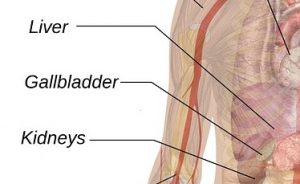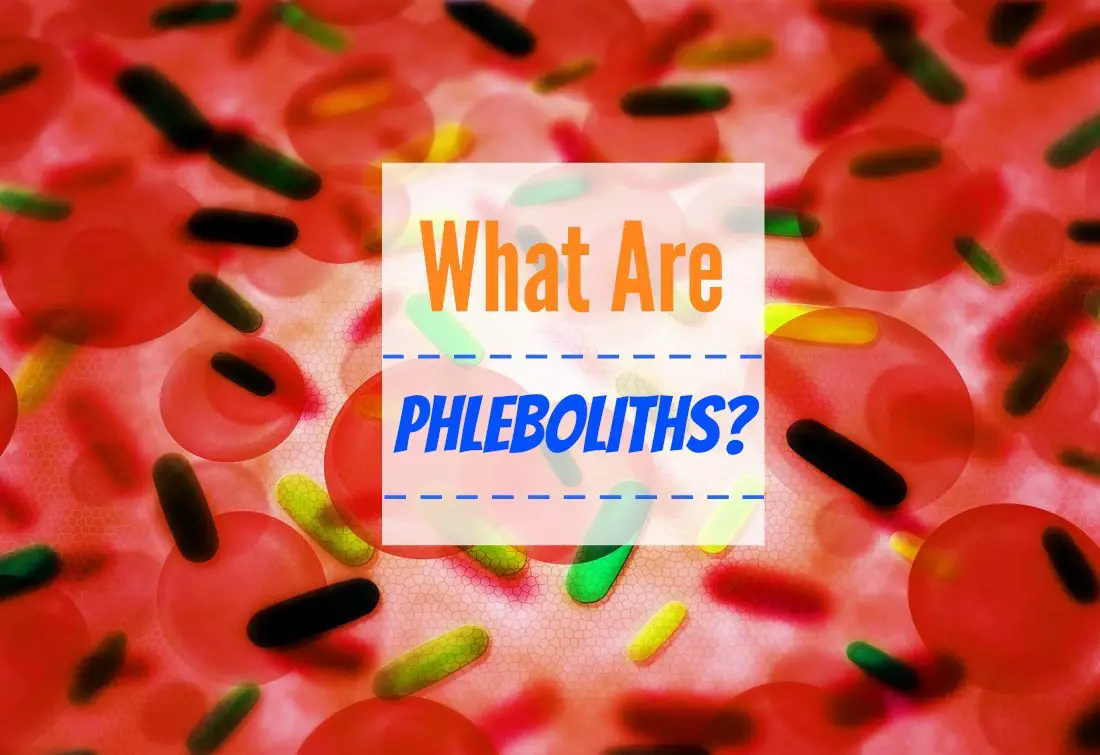Have you been diagnosed with phleboliths?
If this is the case, then you may have many questions about this common medical condition, including how it can be treated and what can be done to prevent it from recurring.
Read on the learn the facts about phleboliths, including their symptoms, treatment, and some tips for prevention, and find links to some research studies that have been done on this condition.
Phlebolith Facts
Doctors performing autopsies in the 19th century first noticed phleboliths in the human body and for years they disagreed over their meaning and treatment.(1)
Now researchers estimate that about 30% of Americans over age 40 have phleboliths.(2)
They are much more rare in children, occurring in only about 1 in 800 cases according to a study of the incidence of pelvic phleboliths in pediatric patients.(3)
What Are Phleboliths?
A phlebolith, also known as a phlebolite, is a “stone” or calcification (a body formed out of calcium) that develops within the wall of a vein.
These stone-like deposits are often seen in x-rays of the lower pelvic region of the body and may appear as round or oval-shaped formations. Less frequently, they’re found in other parts of the body, including the intestines, the stomach, and the scrotum.
Theoretically, phleboliths can form in any vein in the body. In general, they are 2 to 5 millimeters in diameter.
Phleboliths are relatively common and are usually not a cause for concern themselves.(4)
They’re often detected during x-rays or CT scans for other, unrelated conditions.
In some cases, phleboliths can signify other health conditions in the body.
For example, people who suffer from diverticulitis are more likely to have phleboliths than people without it.
Phleboliths are about equally common in men and women. Interestingly, people from economically developed countries appear to have phleboliths more frequently than people from less-developed countries.
What Causes Phleboliths?
 A number of factors inside the body can contribute to the formation of phleboliths.
A number of factors inside the body can contribute to the formation of phleboliths.
These include:(5)
- Liver Disease. Although phleboliths are most commonly found in the pelvis, the phleboliths that are produced as the result of liver disease are specifically formed in the stomach and intestines.
- Straining During Bowel Movements. Chronic constipation can cause people to strain when having bowel movements. Straining during bowel movements increases blood pressure, which can contribute to the formation of phleboliths as well as causing other organ damage.
- Varicose Veins. Varicose veins are veins that have become dilated due to being overtaxed, tired, and stressed. Over time, the valves within the veins that keep blood flowing upward toward the heart weaken and malfunction, causing blood to flow sluggishly, which in turn causes the vein to become permanently swollen and distended.
- Vein Injury. Any injury to the veins that causes or is caused by increased pressure can contribute to the formation of phleboliths.
- Venous Malformations. Veins normally have interior walls lined with smooth muscle tissue (the endothelium), but for a variety of reasons, venous malformations may occur anywhere in the body.(6) These areas of the vein wall are formed without adequate smooth muscle tissue, and these inadequate areas can weaken over time. Areas that have been weakened are more likely to allow phleboliths to form.
Symptoms
 Many people have phleboliths that will never cause any symptoms.
Many people have phleboliths that will never cause any symptoms.
In other cases, symptoms of phleboliths can manifest as pain in the lower back, the abdomen, or the pelvic region.
Pain may be specifically located in the area of the kidneys or the bladder, although this is not always the case. If you can specifically locate the area that is causing the most pain, phleboliths will be easier to diagnose.
These symptoms are very similar to the symptoms of a kidney stone, and in fact, it can be hard for doctors to tell phleboliths apart from kidney stones using only an x-ray.
Pain from a phlebolith can occur with or without a varicose condition in the vein that contains the phlebolith.
Another possible symptom of phleboliths is thrombosis.
Thrombosis is the presence inside the vein of a thrombus, or blood clot that remains stationary against the wall of a blood vessel.
Blood clots that occur in a limb may cause the limb to feel stiff and painful.
If you have thrombosis, your blood flow may be impeded, causing the blood flow through your vein to slow down.
However, most people aren’t able to detect for themselves that their blood flow has slowed down.
Thrombosis may be detected only through testing for an unrelated problem.
When Should I See a Doctor?
 Phleboliths that cause any pain or discomfort should be evaluated by a health care provider.
Phleboliths that cause any pain or discomfort should be evaluated by a health care provider.
See a doctor if you have a history of phleboliths and experience any rectal bleeding.(7)
Doctors have found that patients who have had phleboliths and also cutaneous hemangiomas must be checked for hemangiomas of the colon and/or the rectum.
A hemangioma (also spelled haemangioma) is a condition characterized by the formation of an abnormal mass of blood vessels that resemble a benign tumor.
These masses may be congenital and are typically found on the skin or in the subcutaneous tissue.
Hemangiomas are relatively rare in the gastrointestinal tract (constituting only 5 to 10% of benign intestinal tumors), but of those patients who experience them, about 50% also have a history of phleboliths and hemangiomas of the skin.
How Do You Treat Phleboliths?
Mild Cases
Phleboliths can be treated with anti-inflammatory medications.
In addition, a patient suffering from phleboliths can cover the affected area with a warm washcloth to help reduce even more of the inflammation.
It may also be helpful to raise the affected area above the heart, if possible, since this decreases the amount of blood that flows around the phlebolith, which may help relieve some pain or discomfort if any is present.
More Severe Cases
In more severe cases where anti-inflammatory medication is not appropriate or has not worked, phleboliths may need to be treated with endovenous laser therapy, sclerotherapy, or surgical excision.
- Endovenous Laser Therapy: The most recent development in treating phleboliths, this treatment involves closing off problematic veins using tiny diode laser fibers. Endovenous laser therapy has already been in use for treating varicose veins. This minimally-invasive procedure can be performed in a hospital or outpatient clinic in about one hour.
- Sclerotherapy: In this procedure, the vein that contains the phlebolith is closed off. A health care provider inserts a needle into the vein and injects a radioactive dye called a sclerosant. The vein shrinks and eventually closes off. However, veins that are closed off using this method may eventually form again and the procedure will have to be repeated. Repeated treatments may cause the vein to shrink and close permanently.
- Surgical Excision: This method is the most extreme and is used only in rare cases. In surgical excision, the surgeon opens up the area around the affected vein and removes both the affected vein and the tissue surrounding it. Because this is the most invasive method and requires the longest recovery time, it is only used as a last resort.
Prevention
If you’ve had pain, discomfort, or other health issues related to phleboliths, you may be wondering what you can do to keep them from recurring.
To help prevent phleboliths from reforming:
» Avoid overly tight clothing, especially around the waist
» Avoid sitting still for too long a period. If you must do tasks that involve sitting for long periods, get up from your seat and stretch your arms and legs at least every half hour
» Drink adequate water to avoid dehydration. Dehydration raises your blood pressure which in turn may lead to the formation of phleboliths
» Eat a diet rich in fiber so you can avoid straining when going to the toilet
Are There Any Scientific Studies on Phleboliths?
Several scientific studies have been done on phleboliths.
Case studies of rare phlebolith-related medical conditions and epidemiological studies of hospital records are among them.
Many can be found by visiting the U.S. National Institutes of Health website.
These studies are written for an audience of health care providers and medical researchers, so the language in them tends to be very scientific.
Conclusion
If you suspect you may have phleboliths:
» See your health care provider right away if you have bladder, kidney, lower abdominal, lower back, or pelvis.
» Treat the symptoms of phleboliths with a warm, wet washcloth over the affected area and, if practical, elevated the area over your heart.
» Take any anti-inflammatory medications that your health care provider prescribes.
» Let your health care provider know if symptoms persist after the course of treatment.
» Avoid tight clothes, dehydration, straining while having a bowel movement (which can be associated with chronic constipation), and sitting still for too long to help keep these calcifications from recurring.
» Consult with your health care provider to determine whether it might be appropriate to treat varicose veins, venous malformations, and other conditions that may contribute to the formation of phleboliths.
References
(1)”ncbi.nlm.nih.gov/pubmed/28114785
(2)”nwhealth.edu/resource/radca/abdoch4.html
(3)”ncbi.nlm.nih.gov/pubmed/263508
(4)”healthresearchfunding.org/phleboliths-symptoms/
(5)”newhealthguide.org/Phlebolith.html
(6)”mountsinai.org/patient-care/service-areas/neurosurgery/areas-of-care/cerebrovascular-center/vascular-malformations/venous-malformations
(7)”ncbi.nlm.nih.gov/pmc/articles/PMC2780108/
Leave Feedback: Was this article helpful?

